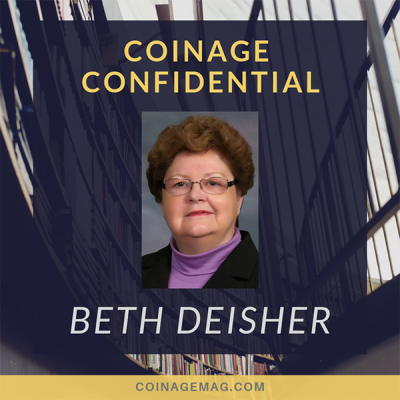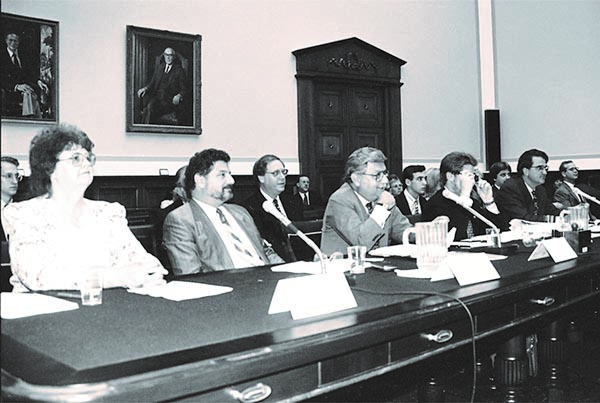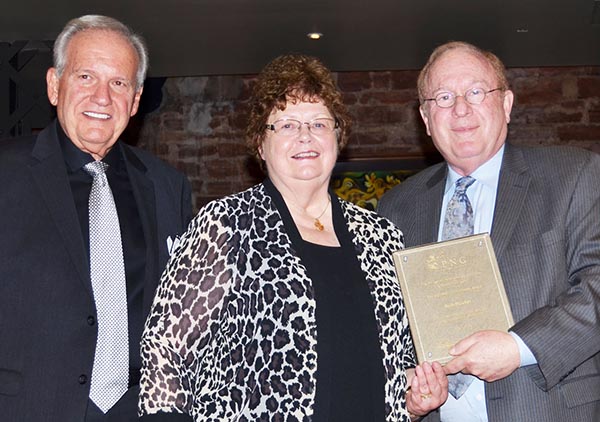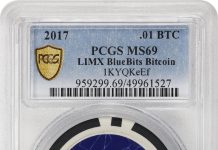
In January of 2017 Beth Deisher was asked by coin industry leaders to leave retirement to lead an effort to combat counterfeit coins entering the United States. She is currently serving as director of anti-counterfeiting and coordinates the work of the all-volunteer 36-member Anti-Counterfeiting Task Force, supported entirely by donations and the 501-C-3 Anti-Counterfeiting Educational Foundation.
The task force and the non-profit foundation share the mission of educating law enforcement authorities and policy makers about the rising threat of counterfeiting, mobilizing law enforcement to attack counterfeiters where they are most vulnerable, and provide expertise and other resources in the investigation and prosecution of counterfeiters and those involved at all levels of their distribution networks. Their mission also includes creating awareness of counterfeits and educating the public about the harmful effects of counterfeits in the marketplace.

Deisher is one of coin collecting’s most trusted authorities. She was editor of Coin World for 27 years (1985-2012). She was also the founding editor of three other numismatic magazines published by Amos Hobby Publishing and is the author or senior editor of 10 books in the numismatic field.
During her first year of retirement from Coin World she wrote Cash In Your Coins – Selling the Rare Coins You’ve Inherited. Published by Whitman Books and now in its second edition, Cash In Your Coins won top awards from the Numismatic Literary Guild and other national writing competitions.
In 2013 Deisher was inducted into the Numismatic Hall of Fame. She is a Fellow of the American Numismatic Society and a member of its Board of Trustees. She holds memberships in many state, regional, and national numismatic organizations, including the American Numismatic Association. In 2010 she received the ANA’s highest honor, the Farran Zerbe Memorial Award for distinguished service in numismatics. She was awarded the Numismatic Literary Guild’s Clemy Award in 1995 and received the Burnett Anderson Memorial Award for journalistic excellence in 2006. In 2017 she received the Professional Numismatists Guild’s Lifetime Achievement Award.

During her tenure as Coin World’s editor she often served as a hobby spokesperson for the general media, with interviews in publications such as the Wall Street Journal, New York Times, Washington Post, USA Today, Los Angles Times, and Forbes magazine. She was interviewed by NBC’s Today Show, Dateline NBC, CBS News, ABC News Tonight, FOX News, Ohio Educational TV, National Public Radio, BBC Radio in London, and dozens of local radio stations in various parts of the United States.

Deisher has provided testimony as an expert witness at five Congressional hearings. In the late 1980s she testified before both the Senate Banking Committee and House Banking Coinage Subcommittee advocating a change in designs for the nation’s circulating coinage. On July 12, 1995, she was the lead witness to testify at a House subcommittee hearing where she cited abuses in the U.S. commemorative coin program and was the first to call for a circulating commemorative program. Legislation resulting from that hearing led to reforms in the U.S. commemorative coin program and also to the 10-year 50 State Quarters® program. In 2010 she testified on needed changes in the marketing of silver, gold, and platinum bullion coins produced by the United States Mint.

In 2001 Ohio Gov. Bob Taft appointed Deisher to the 11-member Ohio State Quarter Committee, which coordinated an out-reach program that resulted in the public submitting some 7,200 design ideas for Ohio’s quarter. She also served on a special committee appointed by the governor to recommend the design that was selected for use on Ohio’s 2003 Bicentennial medal.
Deisher has also provided leadership in professional organizations such as Ohio Professional Writers, which she served as president from 2006 to 2008. Three times during her 47-year membership in the National Federation of Press Women she has been recognized on the national level as a Communicator of Achievement in Ohio, the most recent being in 2009. She is a 47-year member of the Society of Professional Journalists and was one of the first two women invited to join the Tidewater Virginia Chapter in 1971, when Sigma Delta Chi opened its ranks to female journalists.

[Q&A]

Is the future of the rare coin marketplace threatened by the proliferation of Chinese counterfeit coins?
The increasing number of counterfeit coins in the marketplace is a real threat to the marketplace and to the hobby in general. When people unknowingly buy counterfeit coins and/or precious metals bars, later attempt to sell them, and are told that their coins or bars are fake and worthless, they feel the sting of being defrauded. Their confidence is shaken, and they form a negative impression of the coin marketplace. Many never buy coins or precious metals bars again.
What is your favorite area of numismatics?
Actually, I have two favorites: Numismatic literature and medals (historic and modern).
The hobby and science of numismatics has a graying population, and very few young people are entering the field. What needs to be done to expand and grow the hobby?
Most coin collectors become interested in coins through forming collections from circulating coins they carry in their pockets and use every day. Then they expand into earlier coinage. We need higher denominations to make our coinage system more functional, which would lead to more people using coins every day. For example, while collectors love Lincoln cents, in practicality what can you buy today for 1 cent? Our lowest denomination coin is a throwaway for the general public. Throughout U.S. history, when a denomination’s practical use became obsolete, it was dropped (half-cent and two-cent coins). If the United States would use rounding, with the 5-cent coin being the lowest circulating denomination and add at least a $2 coin to the mix, coins would become relevant to the average person. In order to stimulate use of the $1 coin, production of the paper dollar must cease. Redesigning the 5-cent and 10-cent coins, with already-mandated new designs for the quarter, plus circulating $1 and $2 coins would go a long way in restoring use of coins and stimulating interest in collecting, especially young people. Cartoon characters and video games will not cause children (or anyone else) to become coin collectors.
What is the role of the American Numismatic Association, and what could it do to help expand the hobby? Do ANA politics help or hurt the hobby?
The American Numismatic Association plays a special role in that it is a federally chartered non-profit organization charged with encouraging people to learn about and collect money and related items. ANA provides many excellent resources, such as its money museum, monthly magazine (The Numismatist), its annual Summer Seminar, a resource-packed website, and two major coin shows each year that provide outreach to the general public and serve the numismatic community. The ANA needs to expand its educational programs and offer them regionally in order to reach more people with hands-on education. Politics is a factor in most organizations. The danger is in allowing politics to overshadow the good work the organization is doing.
What is the future of coin shows and conventions? What makes the FUN show so perennially successful, while other shows are on the verge of obsolescence?
The rise of the internet does not necessarily spell the doom of coin shows. People spend time and money on their leisure-time interests. For example, fans follow their favorite sports teams on all levels – local, college, and professional. The costs of attending games and associated sports events continues to rise. You have to have engaged and devoted people who give their interests or hobby, and to some extent investments, a priority in their lives. They also have to have enough money to support their interests. The highly successful Florida United Numismatists show offers opportunities to buy and sell collectibles in a friendly and inviting environment plus education and exposure to new collecting opportunities. The FUN show is also located in a desirable climate and has a large supportive base of collectors within driving distance. If you with to experience a actual gambling vibe you could play live dealer roulette online. This means you will play with a human dealer and other gamblers through camera. Discover the top live roulette casinos at exycasinos.ca article, those sites are tested and licensed. Also, it helps to be near an international airport to make travel easy from distant states and countries.
How would a cashless world affect coin and banknote collecting?
I’m not convinced the world will be entirely cashless for decades to come. Collecting money in various forms is rooted in a desire to understand history and nostalgia for the past. If the world were entirely cashless, there would still be those interested in how people used to live, work, and engage economically. For example, coins of the ancient Greeks and Romans are not used in commerce today, but they are avidly collected, studied, researched, and written about.
What motivated you to become a key figure in exploring issues relating to counterfeit coins in the U.S.?
I became aware of problems related to modern counterfeits of U.S. coins through reader complaints to Coin World in 2007. We decided to launch an investigation and became aware that the guide at the New York Times’s web site, Aboutcoins.com, had also begun to investigate. We made contact and decided to pool our resources and share information, which culminated in a three-part series published in Coin World in December of 2008. The series revealed that there were at least 100 counterfeiting operations in China producing fakes of U.S. coins of various levels of deceptiveness. They were all using the internet – primarily eBay at the time – to penetrate the U.S. coin market.
Does our hobby and industry understand the implications of buying and selling counterfeit coins?
While most dealers and collectors know that counterfeiting of U.S. coins and paper money is against the law, it is unclear whether they fully comprehend the relevancy and impact of U.S. laws relating to counterfeiting.
Is it your understanding that it is not legal in the U.S. to buy or sell a counterfeit coin?
U.S. Code, Title 18, Part I, Chapter 25, Sections 485 through 492 clearly state that it is illegal to knowingly possess, buy, or sell counterfeits of U.S. coins and paper money. Further, it states that all counterfeits are to be turned over to the U.S. Secret Service. There are no provisions in the law for anyone or any entity to hold counterfeit coins or paper money in collections for any purpose.
Is it your understanding that it is not legal in the U.S. for a grading service to return a coin to the submitter that it reasonably believes to be counterfeit?
No. Grading services are not law enforcement agencies. A grading service renders a professional opinion and returns the item to the owner with a written statement advising it believes the submitted item is not genuine. It is similar to a coin dealer being offered a coin or bank note, which upon inspection the dealer concludes is counterfeit. The dealer should advise the owner of his opinion and should not purchase the coin. Neither coin dealers nor grading services have any authority to “confiscate” any counterfeit coin, bar, or bank note. They should, however, advise the owner to turn the counterfeit over to U.S. Secret Service. If the Secret Service is not readily available, the counterfeit should be turned over to local police, who will forward to the Secret Service.
What is the position of the U.S. Secret Service on the issue of counterfeit coins sales?
I do not speak on behalf of nor do I represent the U.S. Secret Service. The Anti-Counterfeiting Task Force has worked closely with the Secret Service and other federal law enforcement agencies during the past two years. While in the past the Secret Service has focused almost exclusively on counterfeits of U.S. paper money, it is now aware of and pursuing cases of coin counterfeiting. The Secret Service enforces the federal criminal laws contained in U.S. Code, Title 18, Part I, Chapter 25, Sections 485 through 492 that state it is illegal to knowingly possess, buy, or sell counterfeits of U.S. coins and paper money.
How prevalent are Chinese counterfeits of U.S. coins?
It is difficult to state or even speculate a specific number. However, we do have some evidence to suggest counterfeiting is pervasive and growing. For example, one case with which the Anti-Counterfeiting Task Force assisted in the past year revealed that if the coins and precious metals bars confiscated during the investigation had been genuine, the current market value would be more than $48 million. That’s just one guy. How many more people in the United States are engaged in selling counterfeits at that level? The task force has assisted with more than two dozen cases, with most ranging at $1 million to $5 million level of fraud. Those are the counterfeits that made it into the United States. The task force also assists the U.S. Customs and Border Protection Service, and during the last two years CBP has intercepted and prevented literally tons of counterfeit coins from entering the United States.
Which Chinese counterfeits of U.S. coins pose the most dangers to buyers?
The Anti-Counterfeiting Task Force has seen counterfeits of every U.S. coin series. The task force conducted a survey of U.S. coin dealers in June of 2018. Among collectible classic U.S. coins, Morgan silver dollars at 71.7 percent led the list of most frequently encountered counterfeits, followed by Trade dollars, 66.6 percent; Seated Liberty dollars, 48.6 percent; Lincoln cents, 35.9 percent; Peace dollars, 33.1 percent; and Early American copper large cents and half cents, 29.7 percent. Among pre-1933 gold U.S. coins, 42. 1 percent of the dealer respondents reported counterfeits of the $2.50 gold coin are the most frequently encountered, followed by fakes of $5 gold, 36.2 percent; $20 gold, 33.4 percent; $1 gold, 33.1 percent; and $10 gold, 27.6 percent. Some 43.3 percent of U.S. coin dealer respondents to the survey reported customers seeking to sell them counterfeit silver American Eagle bullion coins. Similarly, 41.2 percent reported customers trying to sell them fake gold American Eagle bullion coins. The most frequently encountered fake foreign gold bullion coins include the South African gold Kruggerand at 30.4 percent, the Canadian gold Maple Leaf at 24.2 percent, and Mexican gold 50 pesos at 20.1 percent.
Does the United States Mint help or hurt the rare coin marketplace?
The U.S. States Mint is the manufacturer and only source of newly minted United States coins. Therefore, it is an essential part of the coin marketplace. The most frequently encountered problems are when the Mint limits or floods the market with its products, particularly those with special finishes or unique qualities produced for the collector market. Also, the U.S. Mint has been unduly slow to use modern technology to protect U.S. coins from counterfeiting, particularly its bullion coins.
What would be the impact on existing grading services and the market if the U.S. Mint were to offer an option to buy the coins it sells certified with grades assigned by skilled Mint graders?
The U.S. Mint has no reason to be in the grading business. Virtually all of the coins it produces should be in the high Mint State or Proof ranges and they are, by definition, genuine. Grading is a business serving the secondary coin market. The U.S. Mint is a manufacturer and sells some of its numismatic products directly to the public. It does not make two-way markets in coins once they enter the secondary market. Unless and until it is a secondary market-maker, the U.S. Mint has no reason to be the owner of a grading service. I am not aware of anyone at the U.S. Mint possessing the knowledge or skill to grade coins. And I doubt congressional committees with oversight responsibility for the U.S. Mint would be inclined to look favorably upon a government agency competing with the secondary market in such a manner.

What is the future of print media?
Specialized or “vertical” print publications have a greater potential for longevity than daily publications. Daily print publications simply cannot compete effectively with the 24-hour news cycle. Larger daily print publications have survived by offering robust websites to complement their print editions. Specialized print publications, such as those serving the numismatic community, have a greater shelf life and have an older subscriber demographic who still prefer holding and reading their publications, even though they also have access to a digital version and websites specializing in numismatic coverage. Many also collect the print versions. Print publications have potential as long as they are providing their readers with relevant and interesting information. Publications lose value when they lose sight of their customers – readers who are collectors.
Support the Anti-Counterfeiting Task Force
The Anti-Counterfeiting Task Force is funded entirely by donations. To support the task force’s work, your tax-deductible donation may be made to the 501-C-3 non-profit Anti-Counterfeiting Educational Foundation, P.O. Box 903, Sylvania, OH 43560 or online. The task force and the foundation share the mission of educating law enforcement authorities and policy makers about the rising threat of counterfeiting, mobilizing law enforcement to attack counterfeiters where they are most vulnerable, and provide expertise and other resources in the investigation and prosecution of counterfeiters and those involved at all levels of their distribution networks. Their mission also includes creating awareness of counterfeits and educating the public about the harmful effects of counterfeits in the marketplace.
Want to receive COINage magazine in your mailbox or inbox? Subscribe today!











